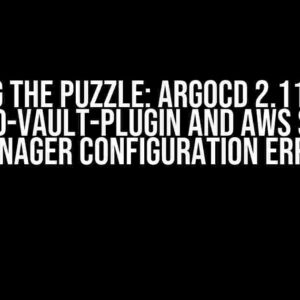Are you tired of manual intervention and repetitive tasks in your workflow? Do you want to automate your processes and make the most of your AWS resources? Look no further! In this article, we’ll explore a design pattern that combines the power of AWS Batch, cron jobs, and RESTful APIs to create a seamless and efficient workflow.
What is AWS Batch?
AWS Batch is a fully managed service that enables you to run batch computing workloads in the cloud. It allows you to easily run large-scale batch processing tasks across a fleet of Amazon EC2 instances, without worrying about the underlying infrastructure. With AWS Batch, you can focus on your application and let AWS handle the heavy lifting.
What is a REST Endpoint?
A REST (Representational State of Resource) endpoint is an API that conforms to the architectural style of the web. It’s a simple, stateless, and cacheable way to interact with a web service. RESTful APIs are widely used in modern web development, and they provide a flexible and scalable way to integrate systems and services.
Why Use Cron Jobs with AWS Batch?
Cron jobs are a type of job scheduler that allows you to execute commands or scripts at specific intervals or times. When combined with AWS Batch, cron jobs enable you to automate your batch processing workflows, ensuring that tasks are executed consistently and reliably. By using cron jobs, you can:
- Schedule tasks to run at specific times or intervals
- Automate repetitive tasks and workflows
- Improve resource utilization and efficiency
- Reduce manual intervention and minimize errors
Design Pattern: AWS Batch Calling a REST Endpoint using Cron
In this design pattern, we’ll create a workflow that uses cron jobs to trigger an AWS Batch job, which in turn calls a RESTful API endpoint. This pattern is useful when you need to automate a batch processing task that requires interaction with an external service or system.
Step 1: Create an AWS Batch Job Definition
First, you need to create an AWS Batch job definition that specifies the container image, command, and resources required to run the job. In this example, we’ll use a Python script that calls a RESTful API endpoint.
aws batch create-job-definition --job-definition-name my-job \
--type container \
--container-properties "{
\"image\": \"python:3.9\",
\"command\": [\"python\", \"script.py\"],
\"resourceRequirements\": [
{
\"type\": \"VCPU\",
\"value\": \"1\"
},
{
\"type\": \"MEMORY\",
\"value\": \"2048\"
}
]
}"
Step 2: Create a Python Script to Call the REST Endpoint
Create a Python script (script.py) that calls the RESTful API endpoint. In this example, we’ll use the `requests` library to make a GET request to a fictional API endpoint.
import requests
def main():
api_endpoint = "https://api.example.com/data"
response = requests.get(api_endpoint)
if response.status_code == 200:
print("API call successful!")
else:
print("API call failed!")
if __name__ == "__main__":
main()
Step 3: Create a Cron Job to Trigger the AWS Batch Job
Create a cron job that triggers the AWS Batch job at a specified interval. In this example, we’ll use a cron job that runs every hour.
crontab -e
*/1 * * * * aws batch submit-job --job-name my-job --job-queue my-queue --job-definition my-job-definition
Step 4: Configure AWS Batch to Run the Job
Configure AWS Batch to run the job by creating a job queue and associating the job definition with it. In this example, we’ll create a job queue with a single instance.
aws batch create-job-queue --job-queue-name my-queue \
--state ENABLED \
--priority 1 \
--compute-environment-order "{
\"order\": 1,
\"computeEnvironment\": \"my-environment\",
\"type\": \"EC2\"
}"
aws batch update-job-queue --job-queue-name my-queue \
--job-definition my-job-definition
Benefits of this Design Pattern
This design pattern offers several benefits, including:
- Automated workflows: By using cron jobs and AWS Batch, you can automate repetitive tasks and workflows, reducing manual intervention and minimizing errors.
- Scalability: With AWS Batch, you can scale your batch processing tasks to meet changing workloads and demands.
- Flexibility: This design pattern allows you to integrate with external services and systems, providing a flexible and scalable way to automate workflows.
- Cost-effectiveness: By using AWS Batch and cron jobs, you can optimize your resource utilization and reduce costs associated with manual intervention and idle resources.
Conclusion
In this article, we’ve explored a design pattern that combines the power of AWS Batch, cron jobs, and RESTful APIs to create a seamless and efficient workflow. By following these steps, you can automate your batch processing tasks, reduce manual intervention, and make the most of your AWS resources.
Remember, this design pattern is just a starting point, and you can customize it to fit your specific needs and requirements. With AWS Batch and cron jobs, the possibilities are endless!
| Resource | Description |
|---|---|
| AWS Batch | A fully managed service for batch computing workloads |
| Cron Jobs | A type of job scheduler for executing commands or scripts at specific intervals or times |
| RESTful API | A simple, stateless, and cacheable way to interact with a web service |
Frequently Asked Question
Here are some frequently asked questions about design pattern AWS Batch calling a REST endpoint using cron.
What is the primary use case for using AWS Batch with a cron trigger?
The primary use case for using AWS Batch with a cron trigger is to run batch processing tasks on a schedule, such as daily or weekly, and to automate tasks that require high processing power or memory. This design pattern is useful when you need to execute tasks that are resource-intensive or long-running, and you want to decouple them from your main application.
How does AWS Batch handle failures when calling a REST endpoint using cron?
AWS Batch provides two ways to handle failures when calling a REST endpoint using cron. Firstly, you can configure a retry policy to retry the failed job execution a specified number of times. Secondly, you can specify a dead-letter queue (DLQ) to which failed jobs are sent for further analysis and debugging.
What is the role of the cron expression in the AWS Batch job definition?
The cron expression in the AWS Batch job definition specifies the schedule on which the job is executed. The cron expression is used to trigger the job execution at the specified time or frequency, such as daily, weekly, or monthly. The cron expression is a string consisting of five or six fields separated by spaces, specifying the minute, hour, day, month, day of the week, and year.
Can I use AWS Batch with a cron trigger to call multiple REST endpoints?
Yes, you can use AWS Batch with a cron trigger to call multiple REST endpoints. You can create multiple job definitions, each with its own cron expression and REST endpoint to call. Alternatively, you can create a single job definition that calls a script or a program that invokes multiple REST endpoints.
How do I monitor and debug AWS Batch jobs that call REST endpoints using cron?
You can monitor and debug AWS Batch jobs that call REST endpoints using cron by using Amazon CloudWatch Logs and AWS X-Ray. CloudWatch Logs provides detailed logs of the job execution, including the output and errors, while X-Ray provides tracing and debugging capabilities to understand the flow of the application and the interaction with the REST endpoint.



